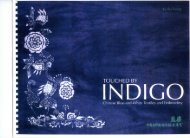Into the Arctic Brochure and Application (PDF) - Royal Ontario ...
Into the Arctic Brochure and Application (PDF) - Royal Ontario ...
Into the Arctic Brochure and Application (PDF) - Royal Ontario ...
You also want an ePaper? Increase the reach of your titles
YUMPU automatically turns print PDFs into web optimized ePapers that Google loves.
Kenneth Lister, Anthropologist<br />
They were agitated at first; uncertain of <strong>the</strong> new circumstances. But, when<br />
<strong>the</strong> motors were silenced <strong>and</strong> <strong>the</strong> zodiacs settled, <strong>the</strong>y seemed to accept our<br />
advances. Although wary, a few chose to slide along beside <strong>the</strong> boat—<strong>the</strong>ir<br />
white skin intense against <strong>the</strong> dark shallows—surrendering to <strong>the</strong>ir own<br />
curiosity. Watching, sitting on <strong>the</strong> safety of <strong>the</strong> zodiac pontoons, <strong>the</strong> mingling<br />
of <strong>the</strong> white whales that day provided us with insight into former times.<br />
Back in <strong>the</strong> comfort of <strong>the</strong> Clipper Adventure’s lounge we reflected upon <strong>the</strong><br />
Inuit hunters of <strong>the</strong> past who armed with harpoons paddled among agitated<br />
pods of whales in skin-on-frame kayaks. It has been reported that <strong>the</strong><br />
Inuvialuit of <strong>the</strong> Mackenzie River Delta undertook orchestrated communal hunts consisting of upward<br />
of 200 hunters. All paddling kayaks <strong>the</strong> hunters pressed whales into shallows where <strong>the</strong> animals found<br />
it hard to escape. This technique was later adopted by <strong>the</strong> Hudson’s Bay Company during annual whale<br />
drives. Series of whaleboats with Inuit crew pushed <strong>the</strong> prey into shallows for successful hunts of<br />
hundreds of whales. In <strong>the</strong> zodiacs that afternoon we came close to experiencing <strong>the</strong> sea-level view of<br />
<strong>the</strong> Inuit kayakers as we imagined <strong>the</strong>m manoeuvring <strong>the</strong>ir craft through thrashing whales intent on <strong>the</strong><br />
hunt as <strong>the</strong>y also focussed upon keeping <strong>the</strong>mselves upright.<br />
From eastern Greenl<strong>and</strong> to eastern Siberia, <strong>Arctic</strong> hunters used <strong>the</strong> kayak for pursuing such animals as<br />
bowhead whales, beluga whales, seals, walrus, narwhal, caribou, <strong>and</strong> birds. Equipped with harpoons<br />
<strong>and</strong> lines, sealskin floats <strong>and</strong> drags, spears, lances, <strong>and</strong> throwing boards, <strong>the</strong> kayak itself was a tool in a<br />
complex of equipment designed specifically for <strong>the</strong> hunt. Short with convex shapes <strong>and</strong> rounded crosssections<br />
for ease of h<strong>and</strong>ling among pods of whales, or long with straighter shapes <strong>and</strong> flattened bottoms<br />
for maximum stability when pursuing seals in open seas, <strong>the</strong> kayak is an exceptional balance of form<br />
<strong>and</strong> function. And <strong>the</strong> kayak itself was dependent upon <strong>the</strong> animals hunted—sealskin for <strong>the</strong> waterproof<br />
cover, caribou sinew for <strong>the</strong> sewing thread, <strong>and</strong> sealskin rope <strong>and</strong> str<strong>and</strong>s of baleen for <strong>the</strong> lashings that<br />
held <strong>the</strong> frame toge<strong>the</strong>r.<br />
In <strong>the</strong> Canadian <strong>Arctic</strong>, two generations have now passed since kayaks have been found on beaches<br />
ready for launching at <strong>the</strong> sightings of whale blows or seal heads appearing like black humps on <strong>the</strong><br />
water’s surface. But kayaks in museum collections are <strong>the</strong> bond to those times. And <strong>Arctic</strong> travel in turn<br />
can provide <strong>the</strong> fleeting moment when we may ourselves sense <strong>the</strong> throb of a paddler’s anticipation <strong>and</strong><br />
joy, such as when we feel <strong>the</strong> bump of a white whale coasting but inches beneath our feet.<br />
Kenneth Lister is a curator of anthropology<br />
at <strong>the</strong> <strong>Royal</strong> <strong>Ontario</strong> Museum <strong>and</strong> 2013<br />
will be his fourth trip with Adventure<br />
Canada. His areas of research include<br />
archaeological fieldwork in nor<strong>the</strong>rn <strong>Ontario</strong><br />
<strong>and</strong> ethnographic research among <strong>the</strong> nor<strong>the</strong>rn<br />
<strong>Ontario</strong> Cree <strong>and</strong> <strong>the</strong> Inuit of Baffin Isl<strong>and</strong>.<br />
Beginning in 2006 he travelled along <strong>the</strong><br />
fur trade canoe routes of nor<strong>the</strong>rn <strong>Ontario</strong><br />
searching for l<strong>and</strong>scape sites sketched by<br />
Canadian artist, Paul Kane (1810-1871),<br />
during <strong>the</strong> mid 19th century. This work<br />
culminated in <strong>the</strong> discovery <strong>and</strong> subsequent<br />
excavation of <strong>the</strong> eastern end of <strong>the</strong> French<br />
Portage in Quetico Provincial Park.<br />
Based upon his <strong>Arctic</strong> research, Kenneth<br />
curated <strong>the</strong> exhibit In <strong>the</strong> Time of <strong>the</strong> Kayak:<br />
Hunting in <strong>the</strong> Eastern Canadian <strong>Arctic</strong><br />
(1994-1996). He curated <strong>the</strong> exhibition<br />
Tuugaaq: Ivory Sculptures from <strong>the</strong> Eastern<br />
Canadian <strong>Arctic</strong> (2002-2003) <strong>and</strong> this work is<br />
now featured in <strong>the</strong> Virtual Museum Website,<br />
Tuugaaq | Ivory | Ivoire. He has curated three<br />
exhibitions devoted to <strong>the</strong> art of Paul Kane:<br />
Wilderness to Studio: <strong>the</strong> Work of Paul Kane<br />
(1984); Wilderness to Studio: Four Views of<br />
Paul Kane (1998-99); <strong>and</strong> Paul Kane: L<strong>and</strong><br />
Study, Studio View (2000-01). Kenneth is<br />
Curatorial Coordinator for <strong>the</strong> ROM’s Daphne<br />
Cockwell Gallery of Canada: First Peoples that<br />
opened in 2005 <strong>and</strong> his most recent exhibition<br />
<strong>and</strong> catalogue was Canada Collects: Treasures<br />
from Across <strong>the</strong> Nation (2007-2008). In 2010<br />
he published <strong>the</strong> award-winning book, Paul<br />
Kane /<strong>the</strong> Artist/: Wilderness to Studio, that is<br />
based upon <strong>the</strong> ROM’s Paul Kane collection.<br />
15

















